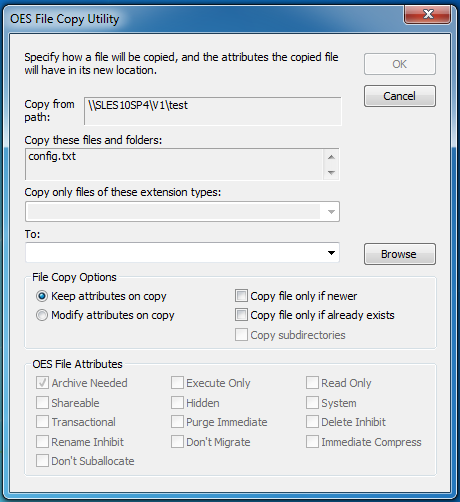2.1 Copying Files to or from a Volume
The OES Copy utility lets you copy files or folders to or from any location you have access to on the network to another network location.
For example, you can use OES Copy to keep two directories synchronized and to preserve OES attributes during a copy.
OES Copy is especially useful if you want to back up your data to a server. Select the parent directory, select OES Copy, and then select the Copy file only if newer check box. This copies only files that have changed, which is a much quicker operation than copying the entire directory structure again.
-
Right-click
 , then click OES Utilities > OES Copy.
, then click OES Utilities > OES Copy. -
Browse to and select the files or folders you want to copy.
-
Click OK.
The OES File Copy Utility dialog box appears.

-
Select the file copy options you want applied to the files you are copying.
Keep attributes on copy: Don’t change the file attributes when you copy the file. The file will have the same attributes in the destination location that it has in the source directory.
Modify attributes on copy: Assign different attributes to the file after copying it than it has in the source directory. Specify the attributes you want to assign to the file in the OES File Attributes list.
Copy file only if newer: Copy the file to the destination directory only if the file you are copying is newer than the file with the same name that already exists in the destination directory. If the file does not exist in the destination directory, the file is copied to the destination directory.
Copy file only if already exists: Copy the file only if a file with the same name already exists in the destination directory.
-
(Optional) Specify the attributes you want applied to the file.
You can specify attributes only if Modify attributes on copy is selected.
Attribute
Description
Archive Needed
Marks the file so it is included if the directory is archived.
Shareable
Allows more than one user to access the file at the same time. This attribute is usually used only on files with the Read Only attribute.
Transactional
Allows a file to be tracked and protected by the Transaction Tracking System™ (TTS™) feature. TTS allows interrupted operations to be backed out of the file, restoring it to an uncorrupted state. All database files that need TTS protection should be marked with this attribute.
-
A file that is flagged Transactional cannot be deleted or renamed.
-
A file cannot be flagged Transactional while it is open.
-
The Modify right is required to flag a file as Transactional.
Rename Inhibit
Prevents the name of the file or folder from being changed.
-
The Modify right is required to change this attribute.
-
A user with the Modify right can change this attribute and then rename the file.
-
This attribute is automatically set and removed when the Read Only attribute is set or removed.
Don’t Suballocate
Previous versions of NetWare® worked with a fixed block size, determined at the time of installation. The block size became the smallest unit of storage on the file server’s hard disk. Generally, the larger the block size, the better the throughput between file server RAM and the hard disk. However, larger block sizes waste disk space. OES subdivides a disk block into smaller suballocation units of 512 bytes. This ensures that disk space is used efficiently.
If you don’t want to use the suballocation units on the files you’re copying, select Don’t Suballocate.
Execute Only
Permanently prevents files from being copied. Copy Inhibit prevents Macintosh* users from copying a file. This attribute overrides Read and File Scan trustee rights.
Hidden
Hides the volume, directory, or file from the DOS or OS/2* DIR command and prevents it from being deleted or copied The OES NDIR command shows the file if the user has File Scan rights.
Purge Immediate
Specifies that this volume, directory, or file is immediately erased from the system if it is deleted. Purged items cannot be recovered.
-
Normally, files deleted by users are saved by OES so they can be salvaged (recovered).
-
To view a list of deleted files in a directory and recover files, right-click the directory name and click Salvage.
-
Normally, deleted files are saved until someone purges them or the OES server runs out of disk allocation blocks on the volume.
-
When a directory is flagged with the Purge Immediate attribute, any file in that directory is purged when the directory is deleted. Those files and directories can’t be recovered with the Salvage option.
Don’t Migrate
Prevents files from being migrated.
Data migration takes files off the server and migrates them onto another media such as a tape or a read/write optical disk. The migrated files are still seen in the directory listing and can be retrieved transparently to the user.
Read Only
Specifies that no one can write to this directory or file. When the Read Only attribute is set or removed, OES also sets or removes the Delete Inhibit and Rename Inhibit attributes. A user can’t write to, erase, or rename a directory or file when Read Only is selected.
System
Marks the file as a system file.
Delete Inhibit
Prevents files and folders from being deleted. This attribute overrides the Erase trustee right.
-
The Modify right is required to change this attribute.
-
A user with the Modify and Erase rights can change this attribute and delete the file.
-
This attribute is set and removed when the Read-Only attribute is set and removed.
Immediate Compress
Specifies that every file in this directory should be compressed as soon as possible after it is closed.
-
-
Click OK to copy the files.